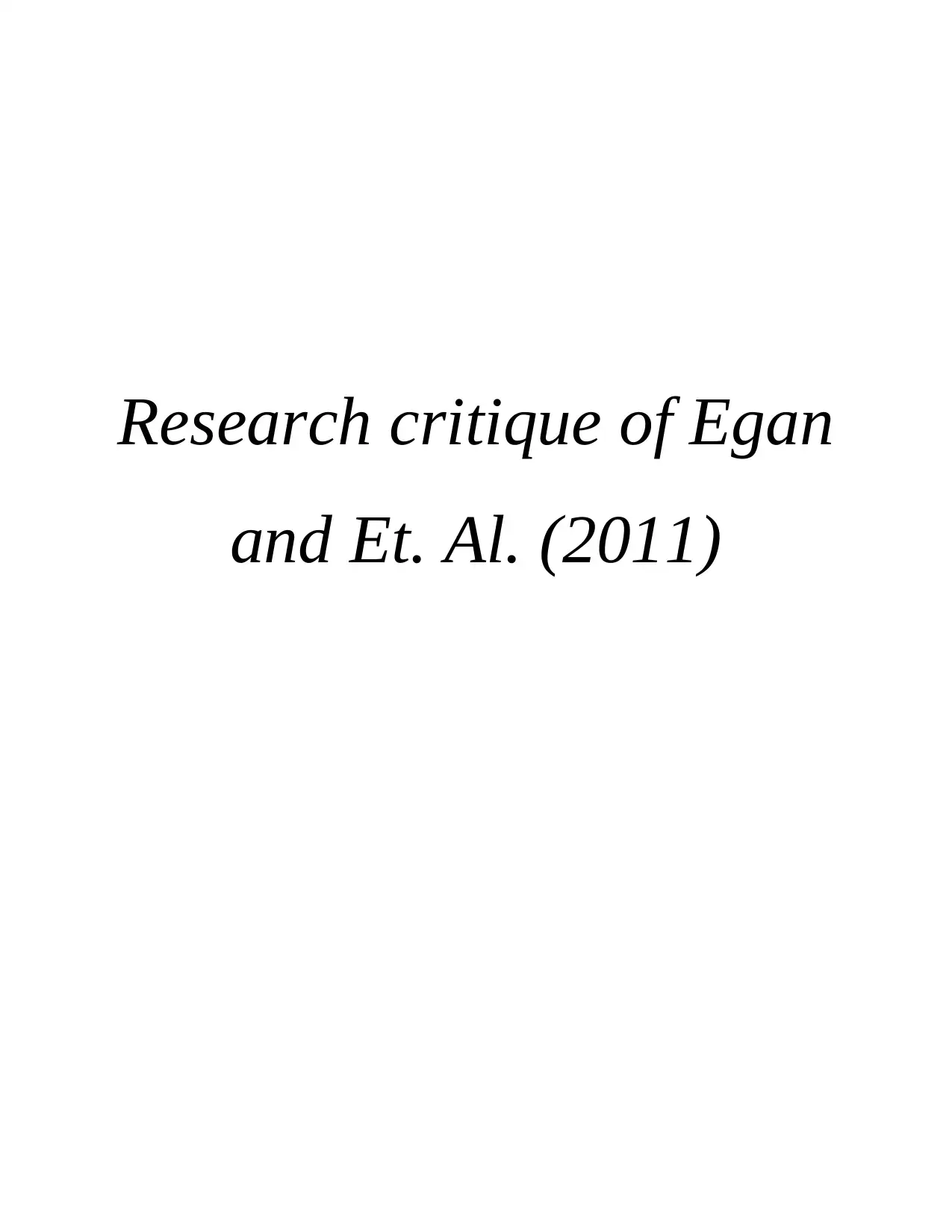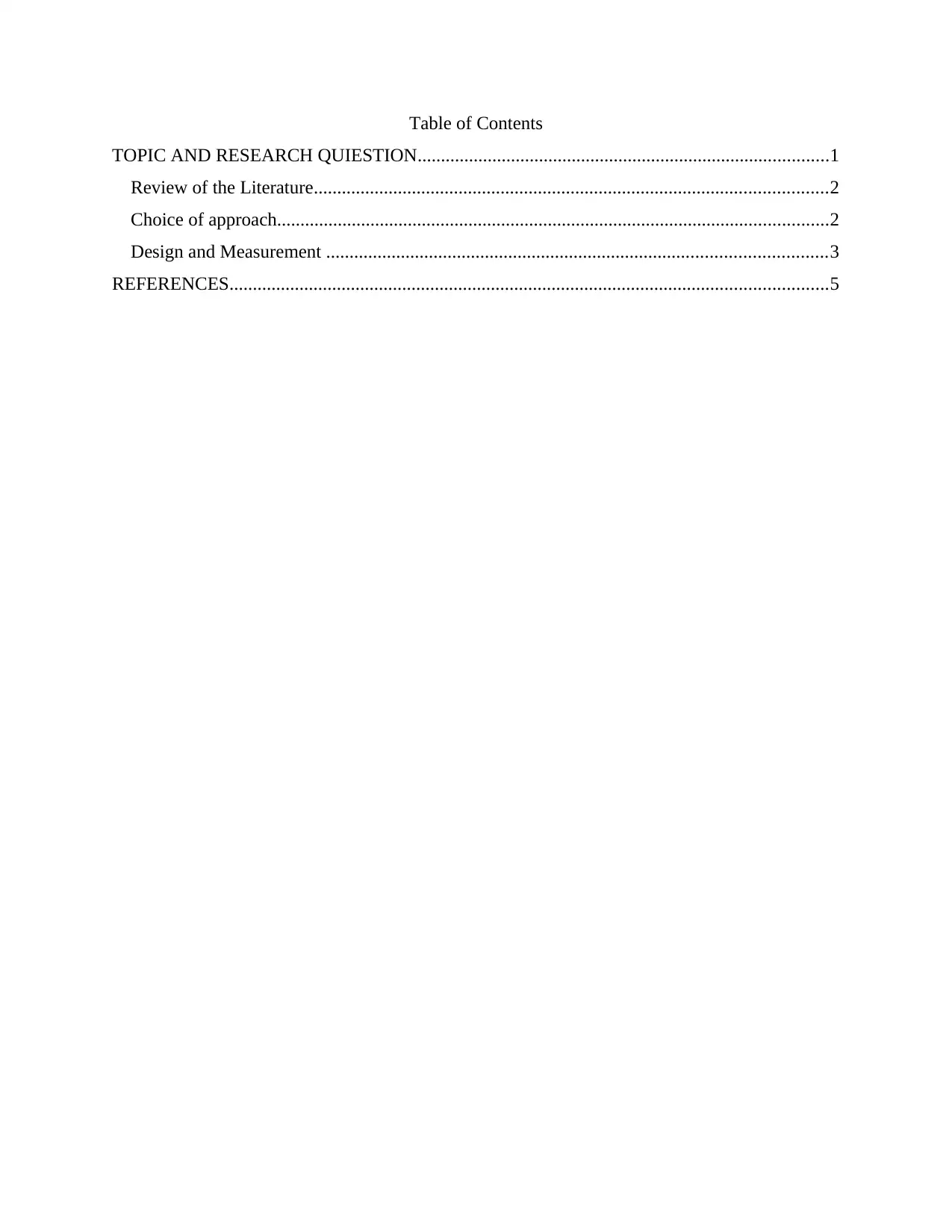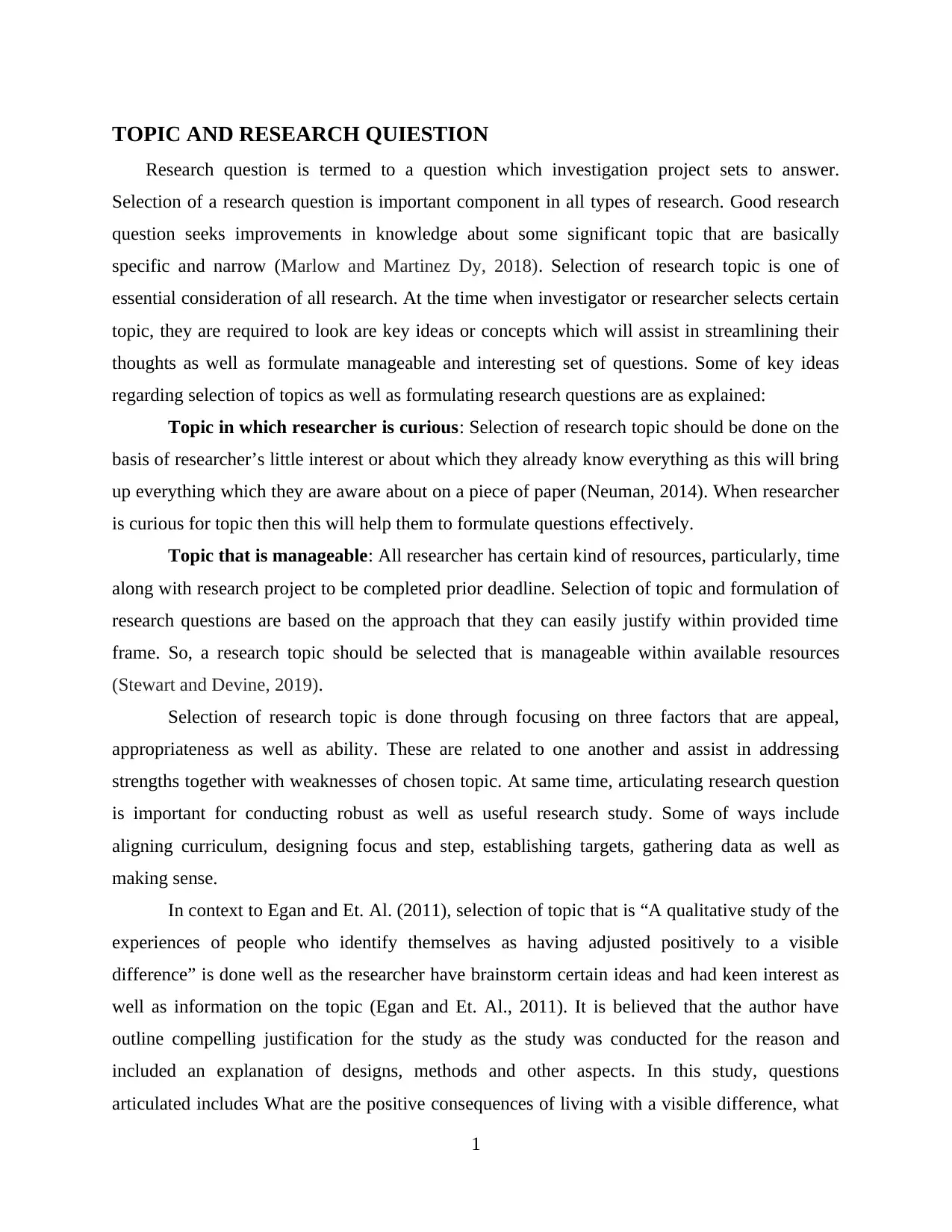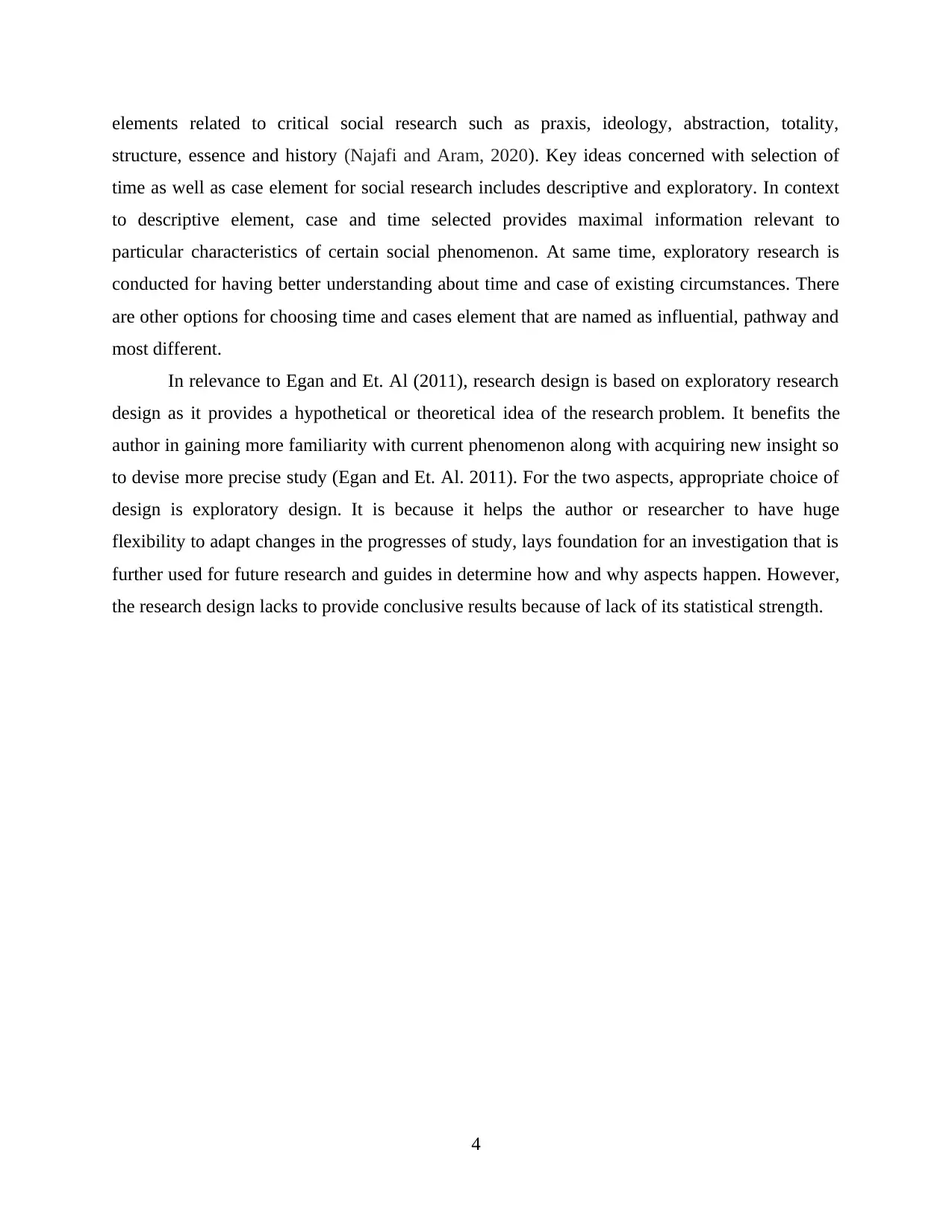Psychology Research Critique: Egan et al. (2011) Study Analysis
VerifiedAdded on 2022/12/12
|7
|1893
|65
Report
AI Summary
This report presents a comprehensive critique of the research conducted by Egan et al. (2011), which focuses on the experiences of individuals who have positively adjusted to a visible difference. The critique begins by examining the research question and topic selection, assessing the clarity and relevance of the chosen focus. It then delves into the literature review, evaluating the author's ability to synthesize and present existing research. The analysis proceeds to scrutinize the choice of research approach, considering the appropriateness of the qualitative and quantitative methods employed. Furthermore, the report assesses the research design and measurement techniques used in the study, highlighting their strengths and limitations. The critique also considers the exploratory research design and its suitability for the study's objectives. Overall, the report offers a detailed evaluation of the research, providing insights into its methodological rigor and contribution to the field of psychology.

Research critique of Egan
and Et. Al. (2011)
and Et. Al. (2011)
Paraphrase This Document
Need a fresh take? Get an instant paraphrase of this document with our AI Paraphraser

Table of Contents
TOPIC AND RESEARCH QUIESTION........................................................................................1
Review of the Literature..............................................................................................................2
Choice of approach......................................................................................................................2
Design and Measurement ...........................................................................................................3
REFERENCES................................................................................................................................5
TOPIC AND RESEARCH QUIESTION........................................................................................1
Review of the Literature..............................................................................................................2
Choice of approach......................................................................................................................2
Design and Measurement ...........................................................................................................3
REFERENCES................................................................................................................................5

TOPIC AND RESEARCH QUIESTION
Research question is termed to a question which investigation project sets to answer.
Selection of a research question is important component in all types of research. Good research
question seeks improvements in knowledge about some significant topic that are basically
specific and narrow (Marlow and Martinez Dy, 2018). Selection of research topic is one of
essential consideration of all research. At the time when investigator or researcher selects certain
topic, they are required to look are key ideas or concepts which will assist in streamlining their
thoughts as well as formulate manageable and interesting set of questions. Some of key ideas
regarding selection of topics as well as formulating research questions are as explained:
Topic in which researcher is curious: Selection of research topic should be done on the
basis of researcher’s little interest or about which they already know everything as this will bring
up everything which they are aware about on a piece of paper (Neuman, 2014). When researcher
is curious for topic then this will help them to formulate questions effectively.
Topic that is manageable: All researcher has certain kind of resources, particularly, time
along with research project to be completed prior deadline. Selection of topic and formulation of
research questions are based on the approach that they can easily justify within provided time
frame. So, a research topic should be selected that is manageable within available resources
(Stewart and Devine, 2019).
Selection of research topic is done through focusing on three factors that are appeal,
appropriateness as well as ability. These are related to one another and assist in addressing
strengths together with weaknesses of chosen topic. At same time, articulating research question
is important for conducting robust as well as useful research study. Some of ways include
aligning curriculum, designing focus and step, establishing targets, gathering data as well as
making sense.
In context to Egan and Et. Al. (2011), selection of topic that is “A qualitative study of the
experiences of people who identify themselves as having adjusted positively to a visible
difference” is done well as the researcher have brainstorm certain ideas and had keen interest as
well as information on the topic (Egan and Et. Al., 2011). It is believed that the author have
outline compelling justification for the study as the study was conducted for the reason and
included an explanation of designs, methods and other aspects. In this study, questions
articulated includes What are the positive consequences of living with a visible difference, what
1
Research question is termed to a question which investigation project sets to answer.
Selection of a research question is important component in all types of research. Good research
question seeks improvements in knowledge about some significant topic that are basically
specific and narrow (Marlow and Martinez Dy, 2018). Selection of research topic is one of
essential consideration of all research. At the time when investigator or researcher selects certain
topic, they are required to look are key ideas or concepts which will assist in streamlining their
thoughts as well as formulate manageable and interesting set of questions. Some of key ideas
regarding selection of topics as well as formulating research questions are as explained:
Topic in which researcher is curious: Selection of research topic should be done on the
basis of researcher’s little interest or about which they already know everything as this will bring
up everything which they are aware about on a piece of paper (Neuman, 2014). When researcher
is curious for topic then this will help them to formulate questions effectively.
Topic that is manageable: All researcher has certain kind of resources, particularly, time
along with research project to be completed prior deadline. Selection of topic and formulation of
research questions are based on the approach that they can easily justify within provided time
frame. So, a research topic should be selected that is manageable within available resources
(Stewart and Devine, 2019).
Selection of research topic is done through focusing on three factors that are appeal,
appropriateness as well as ability. These are related to one another and assist in addressing
strengths together with weaknesses of chosen topic. At same time, articulating research question
is important for conducting robust as well as useful research study. Some of ways include
aligning curriculum, designing focus and step, establishing targets, gathering data as well as
making sense.
In context to Egan and Et. Al. (2011), selection of topic that is “A qualitative study of the
experiences of people who identify themselves as having adjusted positively to a visible
difference” is done well as the researcher have brainstorm certain ideas and had keen interest as
well as information on the topic (Egan and Et. Al., 2011). It is believed that the author have
outline compelling justification for the study as the study was conducted for the reason and
included an explanation of designs, methods and other aspects. In this study, questions
articulated includes What are the positive consequences of living with a visible difference, what
1
⊘ This is a preview!⊘
Do you want full access?
Subscribe today to unlock all pages.

Trusted by 1+ million students worldwide

are these considered positive and what facilitates the positive experiences. The questions and
hypothesis in the study are articulated clearly as these are done in logical, sequential and
understandable manner. Questions could have improves the choices of researcher through
collecting new information, learning about new abilities and establishing new relationship as
these play key role in enhancing credibility of choices relating to formulating articulated
questions in concise manner.
Review of the Literature
Literature review is delineated to a survey done on scholarly sources about particular
topics. It gives overview of current knowledge that allows researcher to determine relevant
theories¸ techniques as well as gaps within existing research (Berg and Slaattelid, 2017). Major
purpose of literature review is gaining understanding about current research as well as debating
relevant to specific topic or any area of investigation in order to present the knowledge in kind of
written report. Conducting literature review Key ideas relevant to reviewing literature includes
ensuring to use right keywords, broadening search area, exploring in depth about relevant
articles, following citations of the articles and hence forth. Reviewing a literature contains a
description, summary as well as conclusion of all the sources. Literature review provides concise
summary of all the content, critical assessment of information and contribution to further
understanding. It builds knowledge of researcher in the field.
In association to Egan and Et. Al (2011), the author have reviewed literature in well form
as they have presented literature by introducing the topic, setting significance of study, providing
overview of some of existing study, devising context for the study through literature, identifying
gaps and illustrating the ways the study will advance knowledge on the topic (Egan and Et. Al.,
2011). Literature review assist author to survey variant scholarly articles along with other
sources which are related to specific issue or area of study. Moreover, the presentation of the
study is in line as per literature means to do. It can be said that the literature review done by the
author could have improved through expanding their vocabulary, using different skills to read
and analyse multiple sources related to the topic, evaluating information as well as publications
for determining noteworthy contribution of literature to scholarship on the topic. With this,
author can bring updated range of knowledge together with ideas which are already established
on eth presented topic.
2
hypothesis in the study are articulated clearly as these are done in logical, sequential and
understandable manner. Questions could have improves the choices of researcher through
collecting new information, learning about new abilities and establishing new relationship as
these play key role in enhancing credibility of choices relating to formulating articulated
questions in concise manner.
Review of the Literature
Literature review is delineated to a survey done on scholarly sources about particular
topics. It gives overview of current knowledge that allows researcher to determine relevant
theories¸ techniques as well as gaps within existing research (Berg and Slaattelid, 2017). Major
purpose of literature review is gaining understanding about current research as well as debating
relevant to specific topic or any area of investigation in order to present the knowledge in kind of
written report. Conducting literature review Key ideas relevant to reviewing literature includes
ensuring to use right keywords, broadening search area, exploring in depth about relevant
articles, following citations of the articles and hence forth. Reviewing a literature contains a
description, summary as well as conclusion of all the sources. Literature review provides concise
summary of all the content, critical assessment of information and contribution to further
understanding. It builds knowledge of researcher in the field.
In association to Egan and Et. Al (2011), the author have reviewed literature in well form
as they have presented literature by introducing the topic, setting significance of study, providing
overview of some of existing study, devising context for the study through literature, identifying
gaps and illustrating the ways the study will advance knowledge on the topic (Egan and Et. Al.,
2011). Literature review assist author to survey variant scholarly articles along with other
sources which are related to specific issue or area of study. Moreover, the presentation of the
study is in line as per literature means to do. It can be said that the literature review done by the
author could have improved through expanding their vocabulary, using different skills to read
and analyse multiple sources related to the topic, evaluating information as well as publications
for determining noteworthy contribution of literature to scholarship on the topic. With this,
author can bring updated range of knowledge together with ideas which are already established
on eth presented topic.
2
Paraphrase This Document
Need a fresh take? Get an instant paraphrase of this document with our AI Paraphraser

Choice of approach
Research approaches are plans and procedures for research that span the steps from broad
assumptions to detailed methods of data collection, analysis, and interpretation. Selection of
choice of research approach depends on nature of study problem and issues which are being
addressed, personal experiences of researcher and audiences of the investigation. There are
various kinds of research approaches including quantitative, qualitative and mixed for collection
information. In quantitative choice, information gathered is expressed in graphs and numbers in
order to confirm assumptions along with theories (Bell and de Gama, 2019). In this idea, factual
information are collected through surveys, experiments and observations. At same time,
qualitative research idea is used for the purpose of understanding thoughts, experiences of people
and concepts through case studies, literature review and other methods. Similarly, mixed method
is a combination of numerical measurements as well as in depth exploration.
In regards to Egan and Et. Al. (2011), quantitative and qualitative approaches are
selected. These choices were appropriate as these are focused, acceptable, scientific along with
objective (Egan and Et. Al., 2011). With these approaches, the author is able to clearly define
problem or approach to the problem. In Qualitative research choice, the author have made focus
towards opinions, descriptions, concepts addition to characteristics. While, through using
quantitative research choice, key emphasis is at measurable together with numerical
relationships. Among the both, better choice of approach is quantitative method over qualitative
methods because it emphasis on testing frameworks together with devising hypothesis, expressed
in statistical and mathematical analysis and learning about respondents patterns. It is critically
analysed that the qualitative research choice benefits in generating content for study, allows for
detail-orientated data to be collected, offers predictive qualities, has flexibility, incorporates the
human experiences and allows creativity to be a driving force. However, it creates misleading
conclusions, relies upon the experience of the researcher, can lose data, require multiple sessions
and difficult to replicate results.
Design and Measurement
Social Research is termed as a method that is used by social scientists addition to researchers
for the purpose of learning about people and societies so that they can design products/services
that cater to various needs of the people. It is generally conducted through following a systematic
plan of action comprising qualitative and quantitative observation approaches. There are certain
3
Research approaches are plans and procedures for research that span the steps from broad
assumptions to detailed methods of data collection, analysis, and interpretation. Selection of
choice of research approach depends on nature of study problem and issues which are being
addressed, personal experiences of researcher and audiences of the investigation. There are
various kinds of research approaches including quantitative, qualitative and mixed for collection
information. In quantitative choice, information gathered is expressed in graphs and numbers in
order to confirm assumptions along with theories (Bell and de Gama, 2019). In this idea, factual
information are collected through surveys, experiments and observations. At same time,
qualitative research idea is used for the purpose of understanding thoughts, experiences of people
and concepts through case studies, literature review and other methods. Similarly, mixed method
is a combination of numerical measurements as well as in depth exploration.
In regards to Egan and Et. Al. (2011), quantitative and qualitative approaches are
selected. These choices were appropriate as these are focused, acceptable, scientific along with
objective (Egan and Et. Al., 2011). With these approaches, the author is able to clearly define
problem or approach to the problem. In Qualitative research choice, the author have made focus
towards opinions, descriptions, concepts addition to characteristics. While, through using
quantitative research choice, key emphasis is at measurable together with numerical
relationships. Among the both, better choice of approach is quantitative method over qualitative
methods because it emphasis on testing frameworks together with devising hypothesis, expressed
in statistical and mathematical analysis and learning about respondents patterns. It is critically
analysed that the qualitative research choice benefits in generating content for study, allows for
detail-orientated data to be collected, offers predictive qualities, has flexibility, incorporates the
human experiences and allows creativity to be a driving force. However, it creates misleading
conclusions, relies upon the experience of the researcher, can lose data, require multiple sessions
and difficult to replicate results.
Design and Measurement
Social Research is termed as a method that is used by social scientists addition to researchers
for the purpose of learning about people and societies so that they can design products/services
that cater to various needs of the people. It is generally conducted through following a systematic
plan of action comprising qualitative and quantitative observation approaches. There are certain
3

elements related to critical social research such as praxis, ideology, abstraction, totality,
structure, essence and history (Najafi and Aram, 2020). Key ideas concerned with selection of
time as well as case element for social research includes descriptive and exploratory. In context
to descriptive element, case and time selected provides maximal information relevant to
particular characteristics of certain social phenomenon. At same time, exploratory research is
conducted for having better understanding about time and case of existing circumstances. There
are other options for choosing time and cases element that are named as influential, pathway and
most different.
In relevance to Egan and Et. Al (2011), research design is based on exploratory research
design as it provides a hypothetical or theoretical idea of the research problem. It benefits the
author in gaining more familiarity with current phenomenon along with acquiring new insight so
to devise more precise study (Egan and Et. Al. 2011). For the two aspects, appropriate choice of
design is exploratory design. It is because it helps the author or researcher to have huge
flexibility to adapt changes in the progresses of study, lays foundation for an investigation that is
further used for future research and guides in determine how and why aspects happen. However,
the research design lacks to provide conclusive results because of lack of its statistical strength.
4
structure, essence and history (Najafi and Aram, 2020). Key ideas concerned with selection of
time as well as case element for social research includes descriptive and exploratory. In context
to descriptive element, case and time selected provides maximal information relevant to
particular characteristics of certain social phenomenon. At same time, exploratory research is
conducted for having better understanding about time and case of existing circumstances. There
are other options for choosing time and cases element that are named as influential, pathway and
most different.
In relevance to Egan and Et. Al (2011), research design is based on exploratory research
design as it provides a hypothetical or theoretical idea of the research problem. It benefits the
author in gaining more familiarity with current phenomenon along with acquiring new insight so
to devise more precise study (Egan and Et. Al. 2011). For the two aspects, appropriate choice of
design is exploratory design. It is because it helps the author or researcher to have huge
flexibility to adapt changes in the progresses of study, lays foundation for an investigation that is
further used for future research and guides in determine how and why aspects happen. However,
the research design lacks to provide conclusive results because of lack of its statistical strength.
4
⊘ This is a preview!⊘
Do you want full access?
Subscribe today to unlock all pages.

Trusted by 1+ million students worldwide

REFERENCES
Books and Journals:
Bell, E. and de Gama, N., 2019. Taking a stand: The embodied, enacted and emplaced work of
relational critique. Organization. 26(6). pp.936-947.
Berg, H. and Slaattelid, R., 2017. Facts and values in psychotherapy—A critique of the empirical
reduction of psychotherapy within evidence‐based practice. Journal of evaluation in
clinical practice. 23(5). pp.1075-1080.
Marlow, S. and Martinez Dy, A., 2018. Annual review article: Is it time to rethink the gender
agenda in entrepreneurship research?. International Small Business Journal. 36(1).
pp.3-22.
Najafi, M. A. and Aram, M. R., 2020. An Evaluation and Critique of the Perspective of Ethan
Kohlberg on Identifying Ithna'Ashariyah Sect with Harbiyah Sect. pazhouhesh
dini. 20(41). pp.259-278.
Neuman. W. L. 2014. Social research Methods. Qualitative and Quantitative Approaches.
Pearson and New International Edition.
Stewart, G. and Devine, N., 2019. A critique of Rata on the politics of knowledge and Māori
education. Waikato Journal of Education. 24(1). pp.92-101.
Egan and Et. Al. 2011. A qualitative study of the experiences of people who identify themselves
as having adjusted positively to a visible difference. Journal of Health Psychology 16(5)
739–749.
5
Books and Journals:
Bell, E. and de Gama, N., 2019. Taking a stand: The embodied, enacted and emplaced work of
relational critique. Organization. 26(6). pp.936-947.
Berg, H. and Slaattelid, R., 2017. Facts and values in psychotherapy—A critique of the empirical
reduction of psychotherapy within evidence‐based practice. Journal of evaluation in
clinical practice. 23(5). pp.1075-1080.
Marlow, S. and Martinez Dy, A., 2018. Annual review article: Is it time to rethink the gender
agenda in entrepreneurship research?. International Small Business Journal. 36(1).
pp.3-22.
Najafi, M. A. and Aram, M. R., 2020. An Evaluation and Critique of the Perspective of Ethan
Kohlberg on Identifying Ithna'Ashariyah Sect with Harbiyah Sect. pazhouhesh
dini. 20(41). pp.259-278.
Neuman. W. L. 2014. Social research Methods. Qualitative and Quantitative Approaches.
Pearson and New International Edition.
Stewart, G. and Devine, N., 2019. A critique of Rata on the politics of knowledge and Māori
education. Waikato Journal of Education. 24(1). pp.92-101.
Egan and Et. Al. 2011. A qualitative study of the experiences of people who identify themselves
as having adjusted positively to a visible difference. Journal of Health Psychology 16(5)
739–749.
5
1 out of 7
Related Documents
Your All-in-One AI-Powered Toolkit for Academic Success.
+13062052269
info@desklib.com
Available 24*7 on WhatsApp / Email
![[object Object]](/_next/static/media/star-bottom.7253800d.svg)
Unlock your academic potential
Copyright © 2020–2025 A2Z Services. All Rights Reserved. Developed and managed by ZUCOL.





